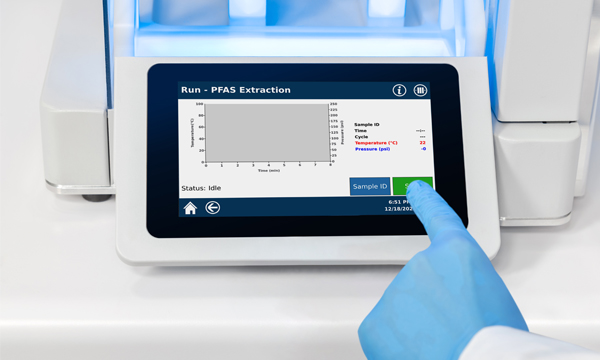Automated Extraction System
EDGE PFAS
Automated Extraction System
EDGE PFAS
Overview
The EDGE PFAS ™ is an automated extraction system that is applicable to solid and semi-solid sample types for PFAS analysis. Perform a complete extraction (including filtering, cooling, and washing) faster than traditional methods. The EDGE PFAS has revolutionized the extraction process for PFAS sample preparation.The EDGE PFAS system does not contain any PFAS-containing materials, enabling the rapid extraction of PFAS without the worry of background contamination.
Features
- Meets the requirements of EPA method 1633
- All components in contact with sample are tested to be PFAS-free
- Reduces the time needed for SPE clean up
- Compatible with a wide variety of sample types
- Sample holders are easily assembled and cleaned (Q-Cups)

Efficient PFAS Extraction
Automation Simplifies PFAS Workflow.
The automated addition of solvent, followed by complete extraction and automated filtration, makes EDGE PFAS the most efficient PFAS system available. Add the sample to the Q-Cup, choose the method, and press start. Once complete, take the extract directly to analysis, reducing operator error, possible contamination sources, and freeing lab time for other tasks.
Flexible
Get better results with one instrument.
- Environmental
- Food
- Consumer Products
- Cosmetics

Q-Cup® Sample Holder
A simple solution to a complicated problem.
The aluminum Q-Cup sample holder consists of three easy-to-assemble pieces.1. Q-Cup Cylinder
2. Q-Disc®
3. Threaded Bottom
The open top creates a dispersive effect which promotes rapid extraction and filtration. The disposable Q-Disc filters your sample prior to analysis. The simple design lends itself to easy cleaning.

Automated Extraction Process
Touch “start” to begin the automated process.
1. Select a MethodAfter a rack of Q-Cups containing samples are loaded into the EDGE, simply select the proper method, program the number of samples, and hit “Start”.
2. Autosampler Loads Sample
The Q-Cup is automatically loaded into the chamber by the autosampler. The pressure cap then creates a pressurized seal on the top of the Q-Cup.
3. Matrix is Extracted Solvent is added through the top of the Q-Cup to wet the sample.
As the chamber walls are heated, the pressure in the gap increases. This overcomes the pressure inside the Q-Cup, forcing the solvent to disperse into the sample.
4. Extract is Collected
Once the sample reaches temperature, the solvent is filtered through the Q-Disc, the cooling coil, and into a collection vial.

Compact
Its small size is a big advantage.
The EDGE is only 14.25” wide. That’s about the width of an analytical balance. You can have multiple EDGE systems placed side-by-side on one bench top.






